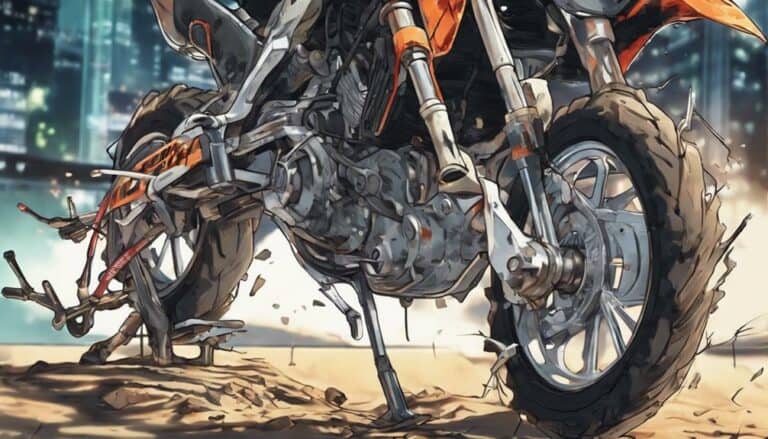So, you've found yourself in a situation where your dirt bike brake cable has snapped in half.
You're probably wondering if there's a simple fix for this common issue.
Well, the truth is, with the right tools and a bit of know-how, you can handle this repair yourself.
But before you rush into any DIY fixes, it's essential to understand the steps involved in properly addressing this problem.
Stay tuned to uncover the tips and techniques that will guide you through efficiently resolving your dirt bike brake cable dilemma.
Key Takeaways
- Carefully assess and inspect the damage to the cable for wear, breakage, or fraying.
- Gather the necessary tools like sandpaper, brazing rod, and torch for effective repair.
- Remove the old cable safely, noting its routing, and dispose of it properly.
- Install the new cable correctly, adjust its length, and test the brake system for optimal functionality.
Assessing the Damage
To properly assess the damage to your dirt bike brake cable, carefully inspect the cable for any visible signs of wear, breakage, or fraying. Start by examining the cable from end to end, checking for any areas where the cable may be broken or weakened. Look closely for frayed sections that could potentially compromise the cable's integrity. If you spot any significant damage, note the location and extent of the break.
Next, make sure to assess if the break is within a critical distance from the end of the cable for a repair to be effective. This step is vital in determining whether fixing the cable is a feasible option. Additionally, consider the overall condition of the cable. Evaluate if the damage is isolated or if there are other signs of wear that might indicate the need for a complete replacement.
Gathering the Necessary Tools
Inspect the damage on your dirt bike brake cable to determine the necessary tools needed for the repair process. For cable preparation, you'll require sandpaper with a grit of 400 to clean and roughen the cable ends for brazing.
Tool selection is important, and you should have a brazing rod with 6-15% silver content for a strong bond between the cable ends. Safety precautions are essential, so make sure you have heat-resistant gloves to protect your hands during the repair.
When applying heat, a propane torch or oxy-acetylene torch can be used to heat the cable ends for brazing. Remember to apply flux to the cable ends before brazing to remove oxides and promote adhesion.
Silver brazing will be the method to join the cable ends together, ensuring a durable and reliable repair. Make sure to have a graphite crucible or carbon rod to hold the cable in place securely during the brazing process.
Before starting, clean the cable thoroughly with rubbing alcohol to remove any contaminants.
Removing the Old Cable
When removing the old dirt bike brake cable, make sure you locate the broken section and identify its connection points with the brake lever and caliper.
Here are some tips for removing the old cable:
- Use pliers to disconnect the cable from the brake lever and caliper, keeping track of any small parts.
- Carefully pull the old cable out of the housing, noting how it was routed for easier installation of the new cable.
- Inspect the cable housing for damage or wear that may have led to the cable breaking.
- Dispose of the old cable properly to avoid any environmental impact.
- Be prepared to install a new brake cable to restore your dirt bike's braking system's functionality.
Installing the New Cable
When installing the new brake cable, carefully thread it through the cable housing and adjust it to the correct length. Begin by inserting one end of the cable into the brake lever, making sure a secure fit. Then, feed the other end through the cable housing, guiding it smoothly to the brake caliper. Attach the cable to the caliper using the appropriate bolts and nuts, making sure it's firmly in place.
Next, adjust the cable tension by manipulating the barrel adjuster at the brake lever. Fine-tune the tension until it's at the best level for efficient braking. Test the brake system by squeezing the brake lever to check for responsiveness and proper function. If needed, make further adjustments to the cable tension to ensure smooth operation.
Remember to regularly inspect the brake cable for any signs of wear and tear to prevent future issues while riding. Proper installation and maintenance of the brake cable are essential for a safe and enjoyable dirt bike experience.
Testing the Brake System
To guarantee peak performance, thoroughly test the brake system on your dirt bike by following these steps:
- Check the brake lever for smooth operation and proper tension to ensure it functions correctly.
- Inspect the brake caliper for any signs of damage, wear, or misalignment that could affect braking performance.
- Test the brake cable tension by pulling on it gently to see if it moves freely and returns to its original position.
- Verify that the brake pads make contact with the rotor evenly and adjust as needed to prevent uneven wear.
- Conduct a test ride in a safe area to confirm that the brake system is responsive and effective before resuming normal use.
Ensuring the brake system is in prime condition is essential for both brake performance and safety. Regular brake cable maintenance is of utmost importance to prevent unexpected failures.
Conclusion
To sum up, fixing a broken dirt bike brake cable can be easily done with the right tools and materials. By following the steps outlined in this article, you can quickly get back on the road with a strong and secure brake system.
Remember, like a well-oiled machine, your dirt bike relies on smooth and efficient operation to keep you riding safely and smoothly. So, don't hesitate to tackle this repair and enjoy the thrill of the ride once again.

